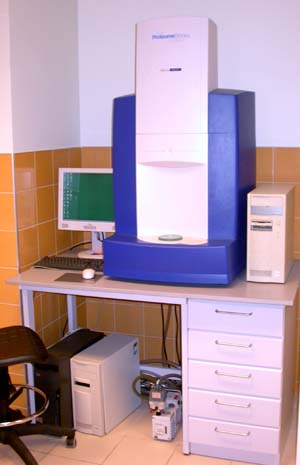Matrix-assisted laser desorption/ionization
Matrix-assisted laser desorption/ionization (MALDI) is a soft ionization technique used in mass spectrometry (MS) allowing the analysis of biomolecules (biopolymers such as DNA, proteins, peptides and sugars) and large organic molecules (such as polymers, dendrimers and other macromolecules), which tend to be fragile and fragment when ionized by more conventional ionization methods. MALDI is of great utility in biochemistry and molecular biology as it allows for the identification, characterization, and quantification of biomolecules directly from complex mixtures.
Principle[edit | edit source]
The MALDI process involves embedding the analyte of interest in a matrix material. Upon irradiation with a laser, the matrix absorbs the laser energy and it is thought to transfer part of this energy to the analyte, resulting in its desorption and ionization. The ionized molecules are then analyzed in the mass spectrometer. The choice of matrix and the laser wavelength are crucial factors that influence the efficiency of the ionization process.
Matrix Selection[edit | edit source]
The matrix is typically a small organic molecule that absorbs ultraviolet (UV) or infrared (IR) light, facilitating the laser desorption process. Common matrices include α-cyano-4-hydroxycinnamic acid (CHCA) for peptides and proteins, and 2,5-dihydroxybenzoic acid (DHB) for sugars and lipids. The matrix and the analyte are co-crystallized on a target plate, and it is this co-crystallized form that is subjected to laser irradiation.
Applications[edit | edit source]
MALDI-MS has become a fundamental tool in various scientific fields, including proteomics, where it is used for protein identification, characterization, and quantification. It is also employed in metabolomics, for the analysis of small molecule metabolites, in pharmacology for drug development and in microbiology for identifying microorganisms. Its ability to analyze a wide range of biomolecules without extensive sample preparation makes it particularly useful for rapid diagnostic applications.
Advantages and Limitations[edit | edit source]
One of the main advantages of MALDI is its high tolerance to contaminants, which allows for the analysis of less pure samples. It also has a high throughput capability due to the rapid nature of the laser desorption process. However, one limitation is the difficulty in quantifying analytes due to the variability in matrix-analyte co-crystallization, which can affect the ionization efficiency. Additionally, MALDI typically requires a solid or semi-solid sample, limiting its application for some types of analyses.
Instrumentation[edit | edit source]
A MALDI-MS system consists of a laser, a mass analyzer, and a detector. The mass analyzer, which can be a time-of-flight (TOF), Orbitrap, or Fourier transform ion cyclotron resonance (FT-ICR) mass spectrometer, separates the ionized molecules based on their mass-to-charge ratio (m/z). The detector then records the intensity of the ions, producing a mass spectrum that can be used to identify and quantify the analytes.
Recent Developments[edit | edit source]
Recent advancements in MALDI technology include the development of imaging MALDI (MALDI-Imaging), which allows for the spatial mapping of molecules within a tissue section. This application is particularly useful in biomedical research for studying the distribution of drugs, metabolites, and proteins within biological tissues.
Search WikiMD
Ad.Tired of being Overweight? Try W8MD's physician weight loss program.
Semaglutide (Ozempic / Wegovy and Tirzepatide (Mounjaro / Zepbound) available.
Advertise on WikiMD
|
WikiMD's Wellness Encyclopedia |
| Let Food Be Thy Medicine Medicine Thy Food - Hippocrates |
Translate this page: - East Asian
中文,
日本,
한국어,
South Asian
हिन्दी,
தமிழ்,
తెలుగు,
Urdu,
ಕನ್ನಡ,
Southeast Asian
Indonesian,
Vietnamese,
Thai,
မြန်မာဘာသာ,
বাংলা
European
español,
Deutsch,
français,
Greek,
português do Brasil,
polski,
română,
русский,
Nederlands,
norsk,
svenska,
suomi,
Italian
Middle Eastern & African
عربى,
Turkish,
Persian,
Hebrew,
Afrikaans,
isiZulu,
Kiswahili,
Other
Bulgarian,
Hungarian,
Czech,
Swedish,
മലയാളം,
मराठी,
ਪੰਜਾਬੀ,
ગુજરાતી,
Portuguese,
Ukrainian
Medical Disclaimer: WikiMD is not a substitute for professional medical advice. The information on WikiMD is provided as an information resource only, may be incorrect, outdated or misleading, and is not to be used or relied on for any diagnostic or treatment purposes. Please consult your health care provider before making any healthcare decisions or for guidance about a specific medical condition. WikiMD expressly disclaims responsibility, and shall have no liability, for any damages, loss, injury, or liability whatsoever suffered as a result of your reliance on the information contained in this site. By visiting this site you agree to the foregoing terms and conditions, which may from time to time be changed or supplemented by WikiMD. If you do not agree to the foregoing terms and conditions, you should not enter or use this site. See full disclaimer.
Credits:Most images are courtesy of Wikimedia commons, and templates, categories Wikipedia, licensed under CC BY SA or similar.
Contributors: Prab R. Tumpati, MD





